Portable Lensed Microcosms Looking Down Into a Frozen World
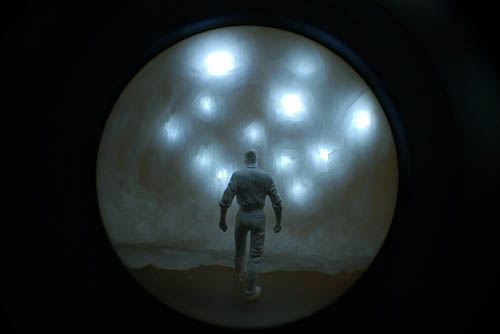 [Image: From "Towards a New Antarchitecture," a thesis project by Taylor Medlin].
[Image: From "Towards a New Antarchitecture," a thesis project by Taylor Medlin].For a stunningly realized thesis project submitted last month at the University of California, Berkeley, Taylor Medlin focused on what he called "Towards a New Antarchitecture." Presented through a combination of miniature wax models and sculpted ice, the project aimed to show how new, more sustainable construction techniques could be developed for the continent of Antarctica.
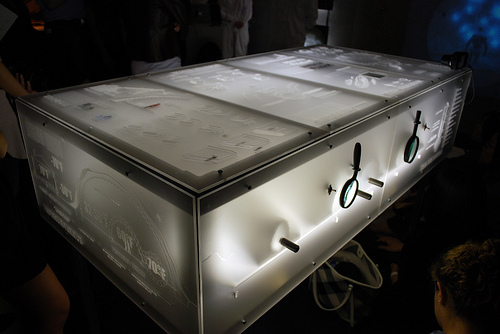
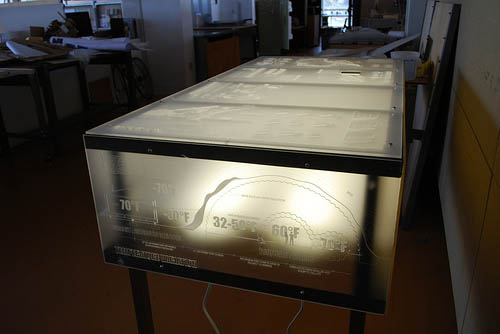 [Images: From "Towards a New Antarchitecture," a thesis project by Taylor Medlin].
[Images: From "Towards a New Antarchitecture," a thesis project by Taylor Medlin].The only slightly tongue-in-cheek project involved everything from Pykrete—sawdust-reinforced ice once proposed as a genuine alternative to steel in constructing warships—to semi-metalized igloos and ice curtain walls threaded with cylinders of glass.
Medlin even created sample ice blocks in a university freezer in order to test a number of these emerging material possibilities. He called this "Ice Experimentation."
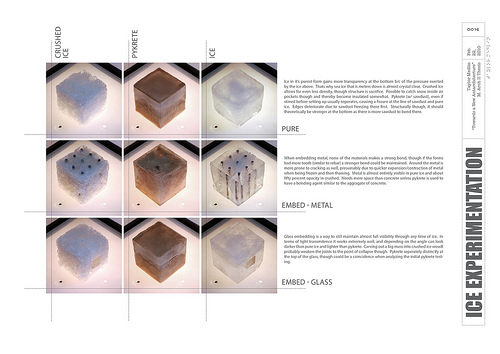 [Images: From "Towards a New Antarchitecture," a thesis project by Taylor Medlin].
[Images: From "Towards a New Antarchitecture," a thesis project by Taylor Medlin].The overall project statement read as follows:
- Antarctica, the most recently explored large land mass in the world, is also currently one of the most unsustainable place on the earth when viewed through the lens of construction techniques. There are over sixty research stations from thirty different countries already built on the continent, all of which are completely constructed out of materials foreign to Antarctica, necessitating huge logistical resources to set up and maintain life there. Though some stations have begun to experiment with energy collection techniques, most remain completely dependent on diesel generators consuming fossil fuels brought from the mainland.
Is it possible to develop construction techniques that take into consideration the materials already present in Antarctica as building blocks for design? And furthermore, what are the possibilities for energy production and conservation that have not yet been explored?
Through the design of a methodology of construction relating to ongoing research stations in Antarctica, I wish to show the plausibility and environmental advantages of designing research stations through the utilization of ice as a principal construction material.
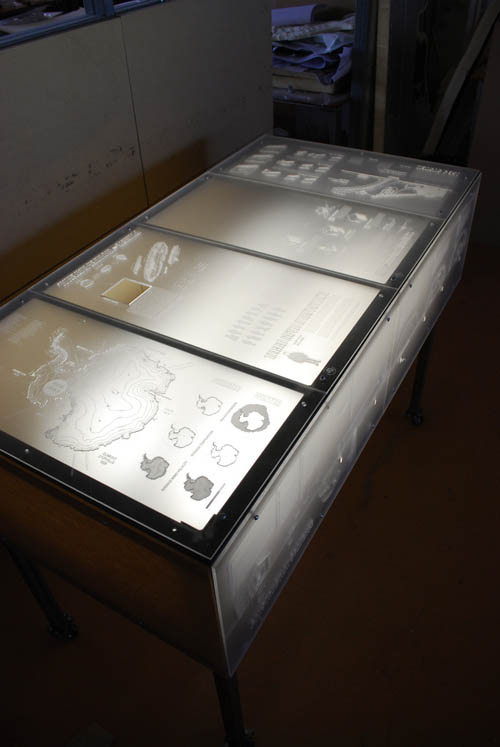 [Image: From "Towards a New Antarchitecture," a thesis project by Taylor Medlin].
[Image: From "Towards a New Antarchitecture," a thesis project by Taylor Medlin].Medlin's execution of the final project cabinet is jaw-dropping. Wax models, fisheye lenses, frozen ice maquettes, human figurines, and laser-etched descriptive text, all often lit from within, result in one of the most beautiful student presentations I've seen in a long time.
Here are some photos, taken by Medlin, starting off with the miniature wax rooms into which his lenses were embedded—reverse-periscopes looking down into a frozen world:

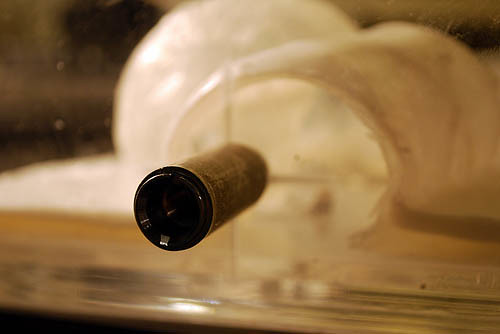
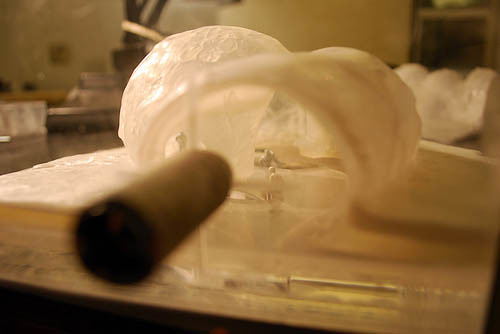
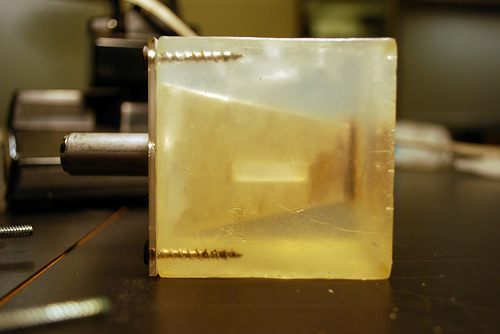 [Images: From "Towards a New Antarchitecture," a thesis project by Taylor Medlin].
[Images: From "Towards a New Antarchitecture," a thesis project by Taylor Medlin].As objects, these are extraordinary; the design potential for portable lensed microcosms is something well worth exploring in other projects elsewhere.
But Medlin offered other ways of seeing into his final project. I think this is genius: in realizing that the fisheye lens approach would not work for everything he'd built, Medlin simply attached magnifying glasses to the exterior of the cabinet. You could thus look through them into a world, one expanding before your very eyes, stocked with people living infra-glacially in an imaginary Antarctic metropolis.
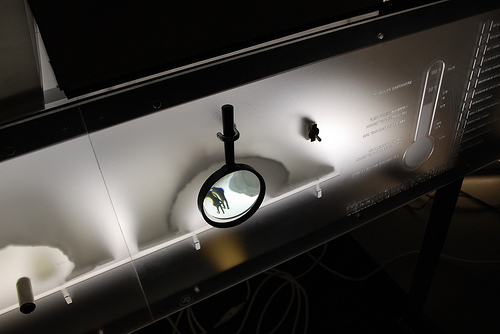
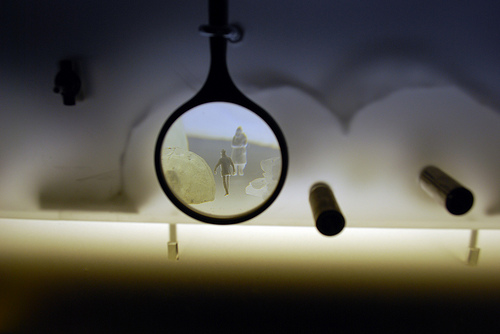
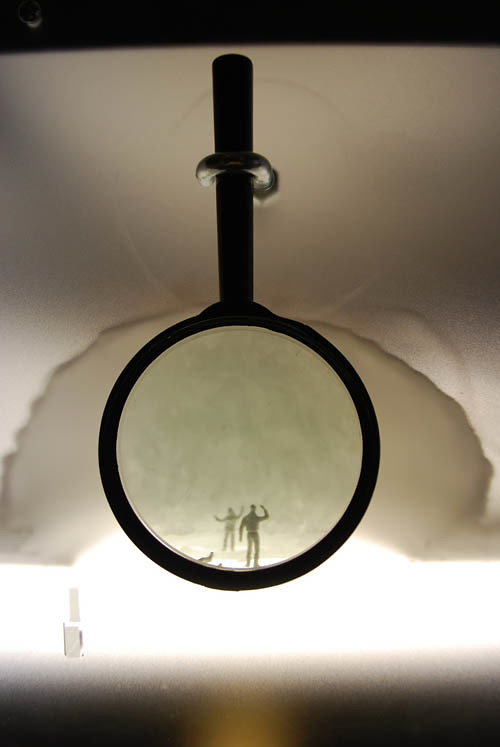 [Images: From "Towards a New Antarchitecture," a thesis project by Taylor Medlin].
[Images: From "Towards a New Antarchitecture," a thesis project by Taylor Medlin].How cool is that!
Here are some of the interior sights those lenses allowed:
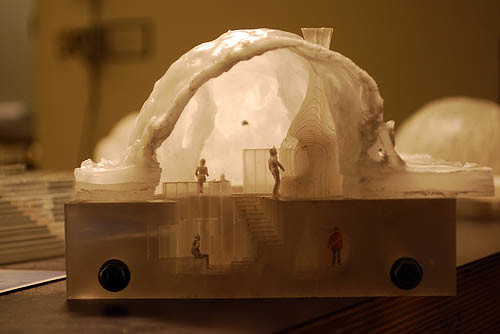
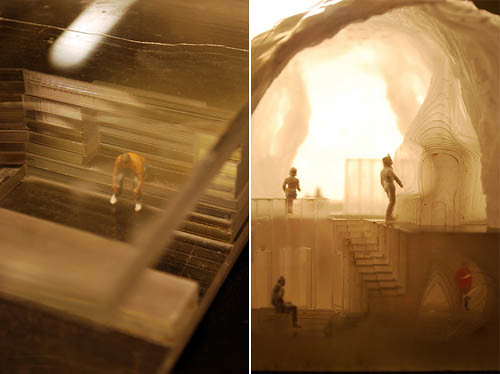
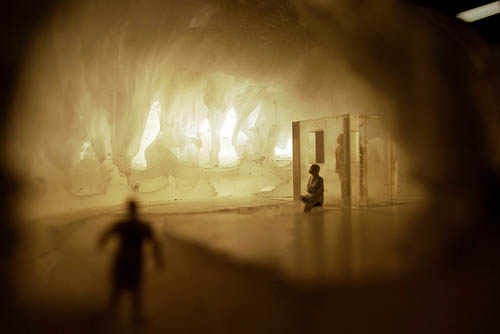
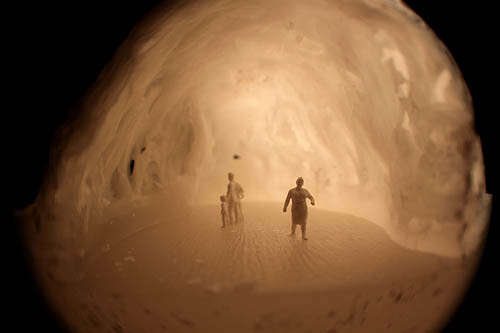

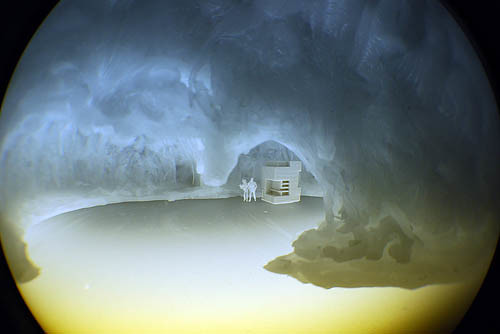 [Images: From "Towards a New Antarchitecture," a thesis project by Taylor Medlin].
[Images: From "Towards a New Antarchitecture," a thesis project by Taylor Medlin].Finally, the ice structures inside of which Medlin's Antarctic researchers—or future sovereign residents—might live ranged from cuboid huts to geodesic ice domes:

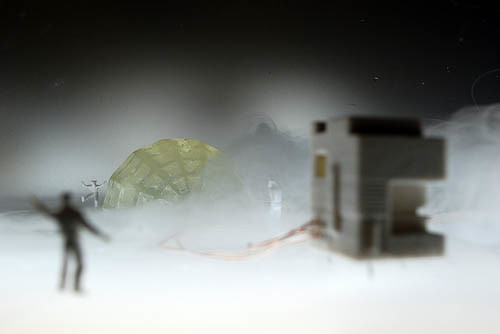 [Images: From "Towards a New Antarchitecture," a thesis project by Taylor Medlin].
[Images: From "Towards a New Antarchitecture," a thesis project by Taylor Medlin].One or two of the resulting scenes are positively mythic, going back to the Nietzschean opening image of this post.
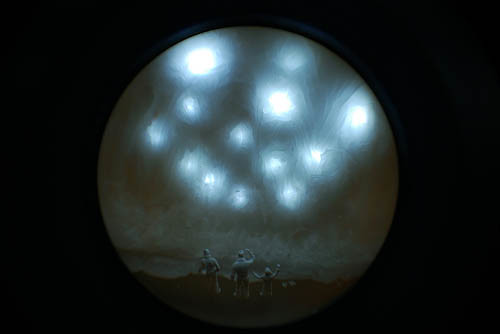 [Image: From "Towards a New Antarchitecture," a thesis project by Taylor Medlin].
[Image: From "Towards a New Antarchitecture," a thesis project by Taylor Medlin].Medlin's behind-the-scenes process documentation is also worth a look; we see him experimenting with battery-powered light sources, hot glue guns, freezer racks, and more. Again, here are some images showing the final display cabinet being assembled.

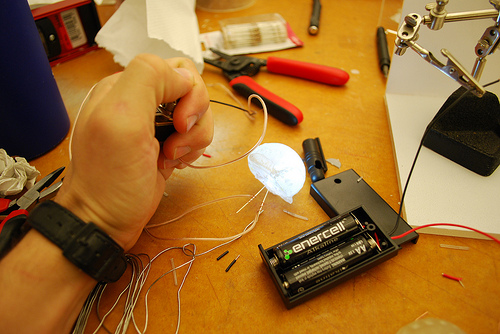
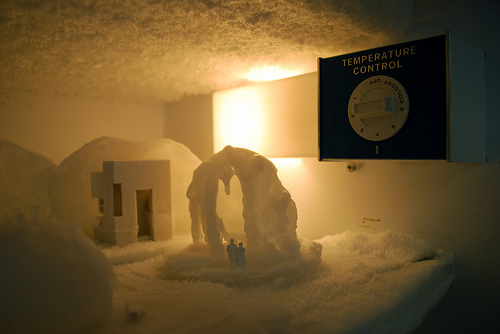
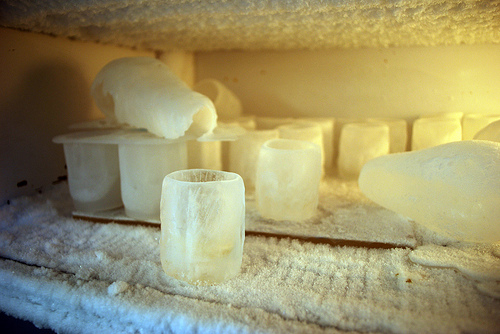

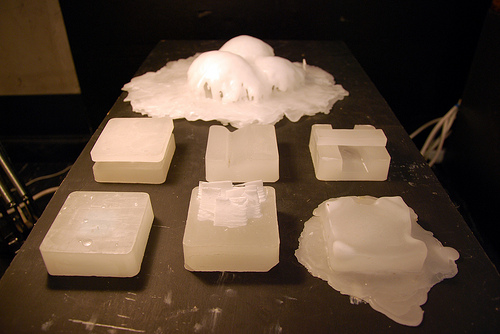 [Images: From "Towards a New Antarchitecture," a thesis project by Taylor Medlin].
[Images: From "Towards a New Antarchitecture," a thesis project by Taylor Medlin].Now ready for public—and advisor—consumption, Medlin's half-frozen, half-wax, optically activated demonstration cabinet of Antarctic wonders stood deservedly proud amidst its surroundings.
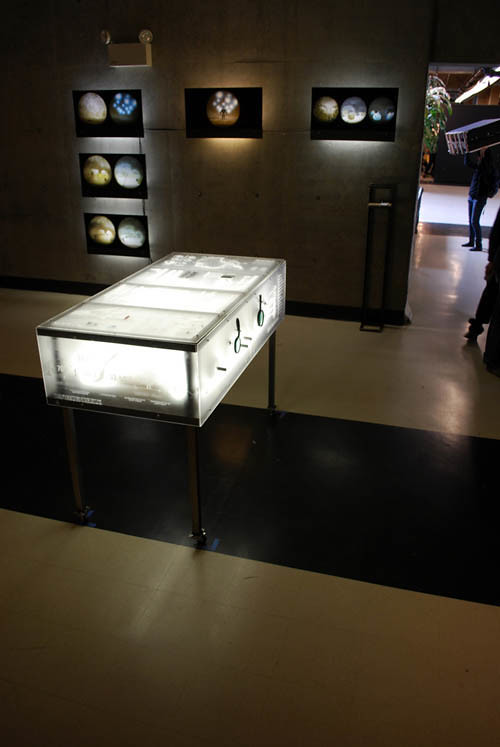 [Image: From "Towards a New Antarchitecture," a thesis project by Taylor Medlin].
[Image: From "Towards a New Antarchitecture," a thesis project by Taylor Medlin].It's worth clicking through the project Flickr page to see many more angles on the work, as well as several whole pages' worth of preparatory images, including templates for the descriptive text that was laser-etched onto the outside of the cabinet.
However, it is also worth taking a spin through Medlin's sketchbook. Extensively detailed in 149 separate scanned pages, it is a treat in its own right. From cave dwellings in both Italy and Turkey to Macchu Picchu, Australian Aboriginal stilt houses, and a bizarre glimpse of tree-borne "baby graves," those sketches collectively form a pretty awesome record of Medlin's recent globetrotting adventures (all of which were funded by a John K. Branner Fellowship, which Medlin's fellow student Nick Sowers, often mentioned here, also deservedly received).
(In the archives: the Antarctic-themed Manual of Architectural Possibilities #1).





Comments are moderated.
If it's not spam, it will appear here shortly!
[This is me standing hand over heart in a state of reverent awe.]
The Brannar is such a great opportunity - really amazing projects have been generated via the fellowship.
Projects like this make me want to go back and do architecture school all over!
So fucking incredible. I aspire to reach this level of commitment when I go back to do Year 4 & 5 next year.
Post a Comment